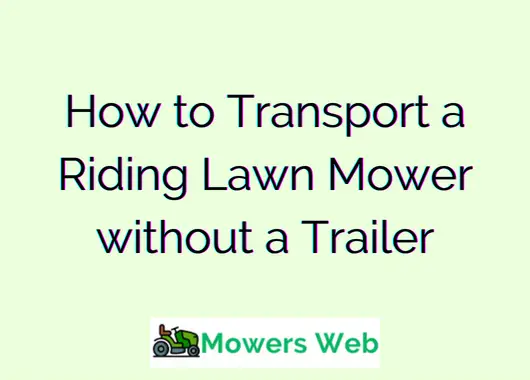Are you in need of transporting your riding lawn mower to a new location but don’t have a trailer to do so?
Don’t worry. It’s still possible to transport your mower without a trailer.
This blog post will provide a comprehensive guide on how to transport a riding lawn mower without a trailer,
including tips on preparing the mower for transport, choosing the right vehicle, and securing the mower during the trip.
Let’s dive in.
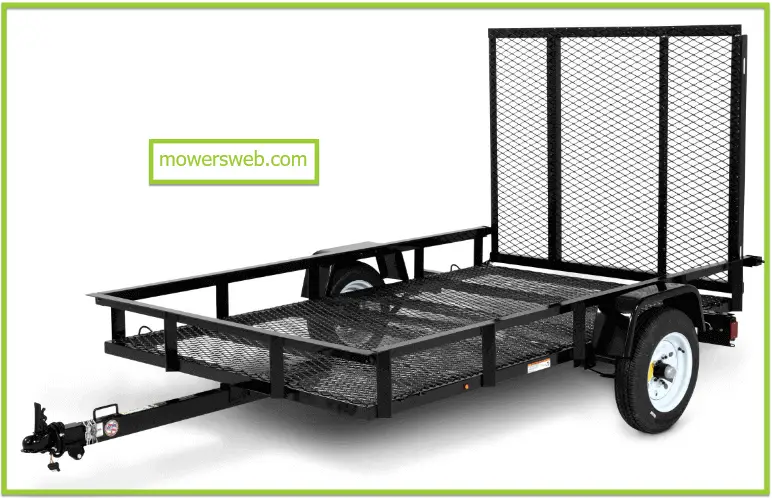
How to Transport a Riding Lawn Mower without a Trailer
Follow these steps, and you’ll be able to safely and successfully transport your lawn mower to its new location.
3 Best Carry on Trailer
1. Carry-On Trailer 5ft. x 8ft. Wood Floor Utility Trailer
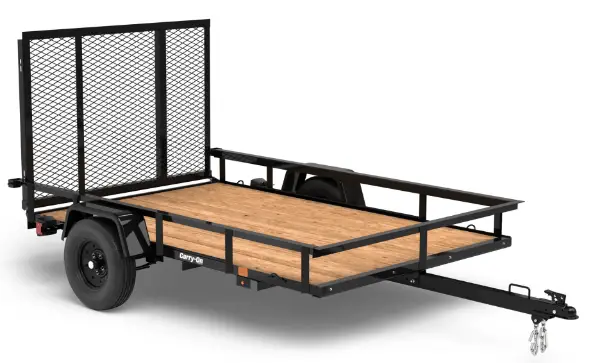
2. Polar Mesh Trailer, Single Axle, 1400-Lb
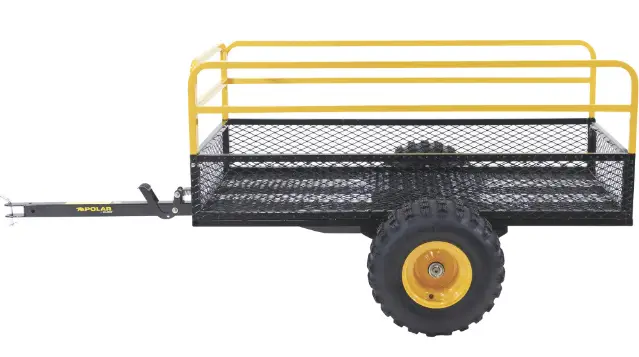
3. Carry-On Trailer 6 ft. x 14 ft. Wood Floor Trailer with Ramp Sides
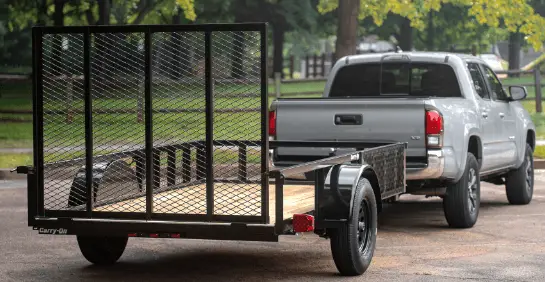
Step 1: Prepare the Lawn Mower for Transport
Before you begin the process of transporting your riding lawn mower, it’s important to prepare the mower for transport.
This will help ensure that the mower is safe and secure during the trip and will also help prevent any damage to the mower or your vehicle.
Here are some steps to follow to prepare your lawn mower for transport:
- Remove the grass clippings and debris from the mower. This will help prevent any messes or damage during transport.
- Check the tires. Ensure that the tires are properly inflated and that there are no cracks or damage to the tread. If the tires are in poor condition, consider replacing them before transporting the mower.
- Check the fuel level. Ensure the fuel tank is not too full, as this can be a fire hazard. If the fuel tank is nearly empty, consider filling it up to help prevent the carburetor from drying out.
- Disconnect the spark plug. This will help prevent the mower from starting accidentally during transport.
Read How to Start Mower After Running Out of Gas(5 Tips)
Step 2: Choose the Right Vehicle
The next step in transporting your riding lawn mower without a trailer is to choose the right vehicle.
You’ll want to choose a vehicle that is large enough to accommodate the size and weight of the mower and one that has a strong and sturdy roof.
Here are a few options to consider:
- Pickup truck: If you have a pickup truck with a sturdy and secure bed, this can be a great option for transporting your lawn mower.
- Just make sure that the bed is large enough to accommodate the size of the mower and that you have enough tie-down straps to secure it.
- SUV or crossover: If you don’t have a pickup truck, an SUV or crossover with a strong and sturdy roof can also transport your lawn mower.
- Just make sure that the roof supports the weight of the mower and that you have enough tie-down straps to secure it.
- Van: If you have a large van, such as a cargo van or minivan, this can also be a good option for transporting your lawn mower.
- Just make sure that the van is large enough to accommodate the size of the mower and that you have enough tie-down straps to secure it.
Step 3: Load the Lawn Mower onto the Vehicle
Once you’ve chosen the right vehicle and prepared the lawn mower for transport, it’s time to load the mower onto the vehicle.
Here are some steps to follow:
- Position the vehicle next to the mower. Ensure the vehicle is parked on a level surface and the brakes are applied.
- Lift the mower onto the vehicle. Depending on the size and weight of the mower, you may need to enlist the help of a friend or family member to lift it onto the vehicle.
- Secure the mower to the vehicle. Use tie-down straps or bungee cords to secure the mower in the vehicle.
- Make sure that the mower is well-secured and that it won’t shift or move during transport.
Read Will a 54 inch Mower Fit on a 5×8 Trailer(Explained)
Step 4: Transport the Lawn Mower
Once the mower is loaded onto the vehicle and secured in place, it’s time to hit the road.
Here are a few tips to keep in mind while transporting your lawn mower:
- Drive slowly and carefully. Since the lawn mower is not secured to a trailer, it will be more prone to shifting and moving during transport. Be sure to drive slowly and carefully to minimize the risk of accidents or damage to the mower.
- Avoid rough roads and bumps. To help prevent damage to the mower, avoid driving on rough or bumpy roads if possible.
- If you do encounter rough roads, try to drive as smoothly as possible to minimize the impact on the mower.
- Use caution when turning. When turning corners or changing lanes, be extra careful to avoid sudden movements that could cause the mower to shift or move.
- Check on the mower frequently. Check on the mower periodically during transport to ensure that it is still secure and well-balanced on the vehicle.
Step 5: Unload the Lawn Mower
Once you’ve reached your destination, it’s time to unload the lawn mower from the vehicle. Here are some steps to follow:
- Position the vehicle next to the unloading area. Ensure the vehicle is parked on a level surface and the brakes are applied.
- Release the tie-down straps or bungee cords. Carefully remove the straps or cords that secure the mower to the vehicle.
- Lower the mower to the ground. Depending on the size and weight of the mower, you may need to enlist the help of a friend or family member to lower it to the ground.
- Reconnect the spark plug. If you disconnected the spark plug before loading the mower onto the vehicle, be sure to reconnect it before starting the mower.
Read How to Tow a Zero Turn Mower (Tips for Safe Transport)
How to keep Mower from moving on Trailer
Use ratchet straps
Securely fasten the mower to the trailer using ratchet straps. Place the straps over the mower and tighten them to hold it in place.
Make sure the straps are tight enough to prevent any movement but not so tight that they damage the mower.
Utilize wheel chocks
Wheel chocks are wedge-shaped blocks that can be placed against the wheels of the mower to prevent them from rolling.
Position the chocks on both sides of the wheels, ensuring they are firmly against the tires, to keep the mower in place.
Consider additional securing methods
Depending on the size and weight of the mower, you may need additional measures to keep it stable.
You can use bungee cords or additional straps to further secure the mower to the trailer. Attach them to stable points on the mower and anchor them to the trailer.
Check for stability
After securing the mower, give it a gentle shake to ensure it is stable and doesn’t move excessively.
If you notice any significant movement, readjust the straps, chocks, or additional securing methods to make it more secure.
Drive cautiously
While transporting the mower, drive with caution, especially when accelerating, braking, or taking turns. Smooth and gradual movements will help maintain the stability of the mower on the trailer.
Read What is the Legal Age to Operate a Lawn Mower?(Find Out!)
How to Safely Transport a Lawn Mower
| Step | Description |
|---|---|
| 1 | Prepare the trailer: Ensure the trailer is in good condition, with working lights, tires, and a secure hitch. |
| 2 | Secure fuel and fluids: Drain or stabilize the fuel tank and oil reservoir to prevent leaks during transportation. |
| 3 | Clean the mower: Remove any debris, clippings, or other materials from the mower to prevent them from falling off during transit. |
| 4 | Lower the cutting deck: If possible, lower the cutting deck to reduce the mower’s height and improve stability during transport. |
| 5 | Disconnect the spark plug: Disconnect the spark plug wire to disable the engine and prevent accidental starting. |
| 6 | Use ratchet straps: Securely fasten the mower to the trailer using ratchet straps. Place the straps over the mower, ensuring they are tight enough to prevent movement but not too tight to damage the mower. |
| 7 | Utilize wheel chocks: Place wheel chocks against the wheels of the mower to prevent them from rolling. Position the chocks on both sides of the wheels and ensure they are firmly against the tires. |
| 8 | Consider additional securing methods: Depending on the mower’s size and weight, use bungee cords or additional straps to further secure the mower to the trailer. Attach them to stable points on the mower and anchor them to the trailer. |
| 9 | Check for stability: After securing the mower, gently shake it to ensure it is stable and does not move excessively. Adjust the straps, chocks, or additional securing methods if necessary. |
| 10 | Drive cautiously: When transporting the mower, drive with caution, especially during acceleration, braking, and turns. Use smooth and gradual movements to maintain the stability of the mower on the trailer. |
| 11 | Comply with regulations: Follow local regulations and guidelines for transporting equipment on trailers, including any specific requirements for securing lawn mowers. |
| 12 | Perform final inspection: Before driving, perform a final inspection to ensure all connections, straps, and safety measures are in place and properly secured. |
Read Can I use a Riding Lawn Mower with a Pacemaker(Is it Safe)
How to Transport a Lawn Mower without a Car
Transporting a lawn mower without a car can be challenging, but here are a few alternative methods you can consider:
- Rent a truck or van from a rental agency.
- Borrow a vehicle from friends, family, or neighbors.
- Utilize a trailer-sharing service in your area.
- Hire a local delivery service or a moving company.
- Check if public transportation allows large or bulky items.
- Explore pick-up and delivery services offered by lawn mower retailers or repair shops.
Final Remarks
It is possible to transport a riding lawn mower without a trailer as long as you follow proper safety precautions and techniques.
By securing the mower properly, following all traffic laws, and using caution while driving, you can ensure your lawn mower’s safe and successful transport.
Read Low Oil Symptoms in Lawn Mowers (Don’t Ignore These Signs)
FAQ
Can I transport a riding lawn mower without a trailer?
Yes, it is possible to transport a riding lawn mower without a trailer. There are alternative methods you can use, depending on your specific circumstances.
What are some alternative methods for transporting a riding lawn mower without a trailer?
- Utilize a pickup truck: If you have access to a pickup truck, you can securely load the riding lawn mower onto the bed. Use ramps or a loading dock to safely drive the mower onto the truck bed, and secure it with straps or bungee cords to prevent it from moving during transit.
- Rent a truck or van: If you don’t own a pickup truck, you can rent a truck or van from a local rental service.
- Follow the same process of loading and securing the mower onto the rented vehicle.
- Use a tow-behind cart: Some riding lawnmowers have tow-behind carts available as accessories. These carts are specifically designed to transport the mower.
- Attach the cart to the back of the mower, load your equipment into the cart, and drive slowly and cautiously to your destination.
- Consider professional transportation: If you’re unable to transport the mower yourself, you can hire a professional transportation service that specializes in moving large equipment.
- They will have the necessary tools and expertise to safely transport your riding lawn mower.
Read How to Make a Lawn Mower Go 40 mph(5 Simple Tips)
What precautions should I take when transporting a riding lawn mower without a trailer?
Here are some important precautions to keep in mind:
- Ensure the riding lawn mower is turned off and cooled down before attempting to transport it.
- Securely fasten the mower to the vehicle using strong straps or bungee cords. Make sure it is stable and won’t move during transit.
- Use caution when loading and unloading the mower, especially if you are using ramps or a loading dock.
- Drive slowly and avoid sudden movements to prevent any damage to the mower or the vehicle.
- Check local regulations regarding the transportation of large equipment to ensure compliance with any specific requirements.
Are there any size limitations or weight restrictions I should be aware of?
Yes, it’s essential to consider the size and weight of the riding lawn mower to ensure safe transportation.
The vehicle you use should be capable of accommodating the dimensions and weight of the mower.
Additionally, verify any legal requirements or restrictions related to the transportation of large equipment in your area.
How can I protect the riding lawn mower during transportation?
To protect the riding lawn mower during transportation:
- Ensure the mower is secured tightly to prevent it from shifting or falling off the vehicle.
- If possible, cover the mower with a tarp or a protective cover to shield it from dust, debris, and weather conditions.
- Avoid sudden stops, accelerations, and sharp turns during transit to minimize the risk of damage.

